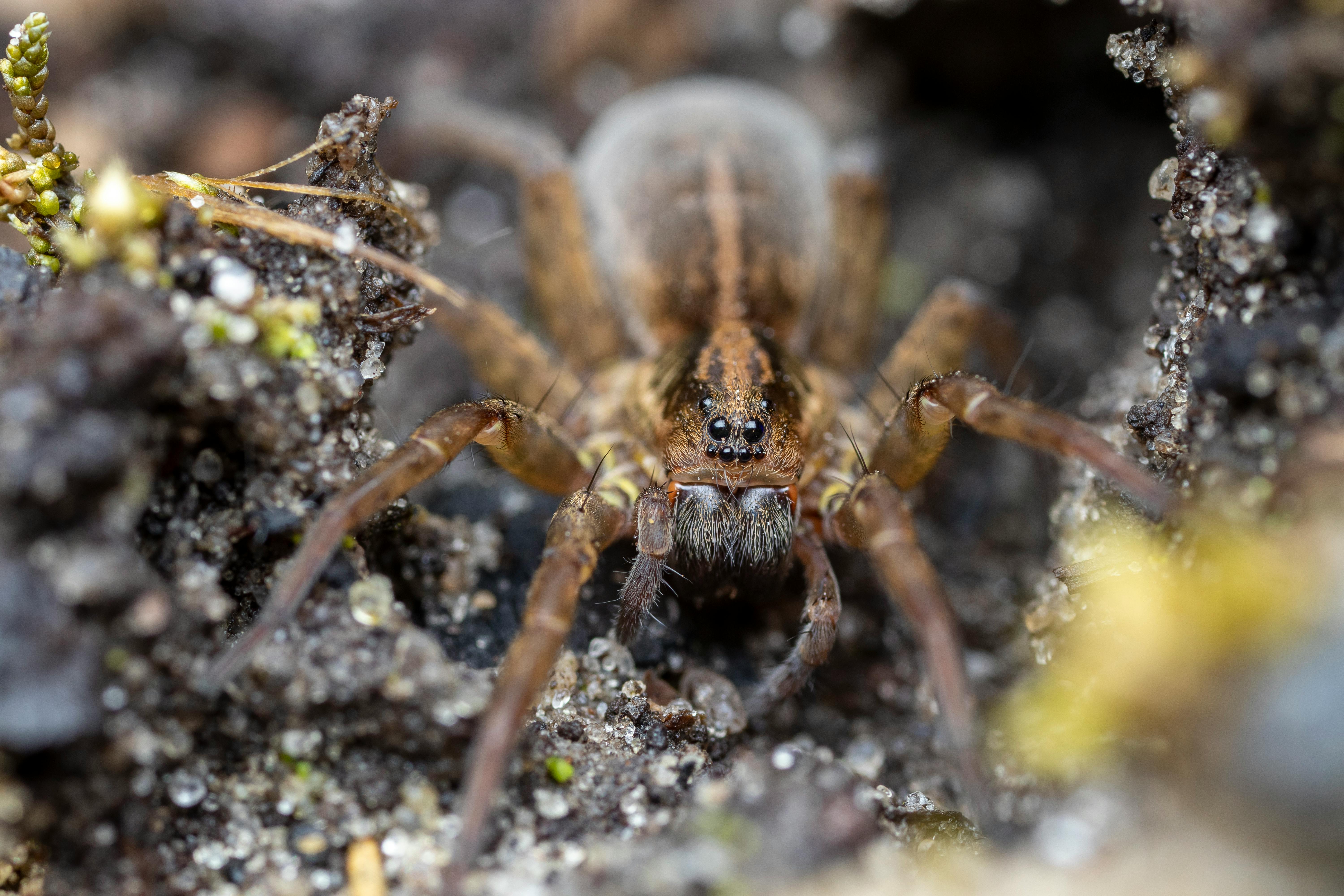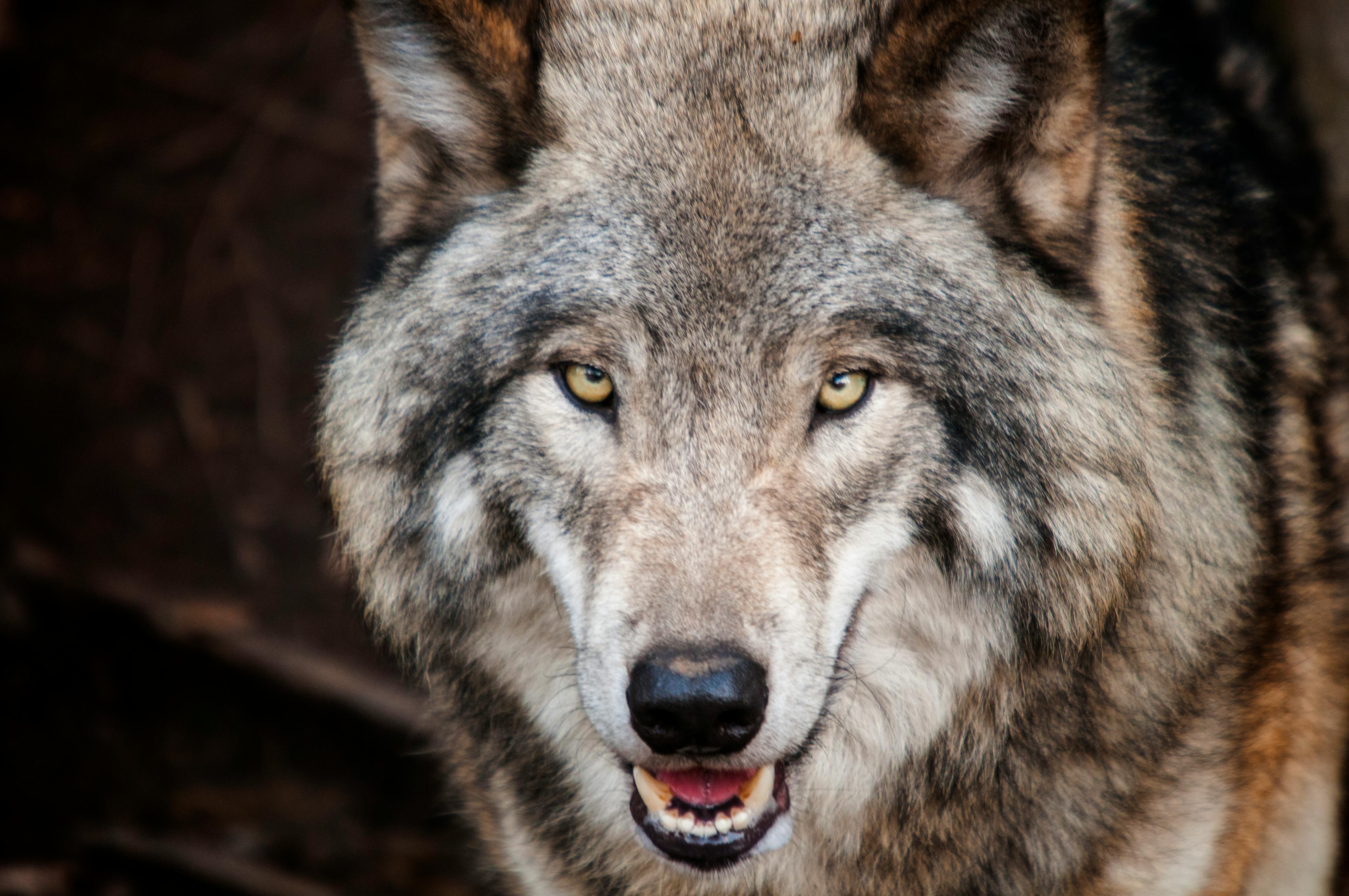Wolf spiders are a type of spider that belongs to the family Lycosidae. They are amongst the most common and recognizable of all spider species, and can be found in many parts of the world. Wolf spiders range in size from small to large and are typically dark brown or black in color. They have eight eyes, two large ones and six smaller eyes, arranged in three rows. These spiders are named after their wolf-like hunting behavior; they hunt down their prey rather than using webs to trap them. Wolf spiders have strong jaws that allow them to pierce their prey’s exoskeleton. They also have impressive senses of sight and smell, both of which help them locate food.A wolf spider is an animal belonging to the family Lycosidae, which contains over 2,000 species of spiders. They are usually dark-colored and have long legs with a distinctively patterned cephalothorax (the fused head and thorax of a spider). Wolf spiders are typically ground-dwellers and are sometimes found in homes. They do not spin webs but instead hunt their prey.
Contents
Physical Characteristics
Wolf spiders are robust, agile predators with excellent vision. They typically have a mottled gray, brown, or black coloration and can range in size from a few millimeters to over an inch in length. Wolf spiders have eight eyes arranged in three rows. The top row is comprised of two small eyes, the middle has four medium-sized eyes, and the bottom has two large eyes. Wolf spiders also have long legs that are covered in tiny hairs which help them detect vibrations from prey.
Habitat
Wolf spiders are common throughout the world and can be found in a variety of habitats including deserts, grasslands, forests, and even urban environments. They are often seen scurrying across open ground or hiding under rocks or logs. Some species of wolf spider live in burrows that they build themselves or occupy abandoned burrows of other animals.
Diet
Wolf spiders are carnivorous predators that feed on a variety of prey including insects, spiders, and other small animals like lizards and frogs. They hunt by stalking their prey and then pouncing on it with their strong legs. Wolf spiders also use their sharp fangs to inject venom into their victims before consuming them.
Reproduction
Most wolf spider species reproduce by laying egg sacs which contain hundreds of eggs at a time. The female will stay with the egg sac until it hatches to ensure its survival before moving on to find new prey. When the young hatch they typically remain together for several weeks before dispersing to find food and shelter on their own.
Where Do Wolf Spider Animals Live?
Wolf spiders are found in many different habitats all over the world. They can be found in deserts, grasslands, forests, and even close to human dwellings. Wolf spiders prefer to live in places with a lot of hiding places such as tall grasses and shrubs. They are also commonly found in leaf litter and among rocks and logs.
Wolf spiders are able to adapt to many types of climates, from hot and dry deserts to cool mountain regions. They can also survive in cooler climates by burying themselves beneath the soil during winter months. Wolf spiders are highly mobile creatures that can be found anywhere from sea level up to elevations of over three thousand meters.
Wolf spiders prefer to hunt on land as opposed to water, so they tend to stay away from aquatic habitats such as streams and rivers. However, some species of wolf spider have been known to inhabit shallow waters for short periods of time. These species often use their webs as a means of catching prey or resting on floating vegetation during the day or night.
Because wolf spiders are nocturnal hunters, they can generally be found resting during the day under stones or logs or inside burrows that they have dug into the ground. During the night they will emerge from their hiding place in order to hunt for prey such as insects and small mammals.
Overall, wolf spiders can be found living in many different environments all over the world. From deserts, grasslands, forests and even human dwellings, these resilient arachnids can thrive almost anywhere!
How Long Do Wolf Spider Animals Live?
Wolf spiders are a type of arachnid that can be found all over the world. They are known for their large size and intimidating appearance, but they are actually quite harmless. Despite their seemingly tough exterior, wolf spiders have relatively short lifespans in the wild, averaging around one to two years. However, in captivity, they can live significantly longer, up to five years or more.
Wolf spiders are solitary creatures who don’t live in colonies or cooperate with other individuals. They hunt alone and spend most of their time on the ground looking for prey. This lifestyle can make them vulnerable to predators and environmental factors such as temperature and humidity that can drastically reduce their lifespan. In captivity, however, these risks are eliminated, allowing them to live considerably longer lives than those in the wild.
The lifespan of a wolf spider is also heavily dependent on its diet and habitat conditions. If they have access to plenty of food and a warm environment where they feel safe from predators, they will likely live much longer than average. As with any animal, proper nutrition is key to a long and healthy life for wolf spiders.
In conclusion, while wolf spiders typically only live 1-2 years in the wild, they can live up to 5 years or more when kept in captivity under proper conditions. It is important to provide them with a healthy diet and secure environment in order to help maximize their lifespan and keep them happy and healthy!
Are Wolf Spider Animals Dangerous?
Wolf spiders are members of the family Lycosidae, and are found in many parts of the world. They are a type of hunting spider, meaning they do not spin webs to catch prey, but instead actively hunt for their food. While wolf spiders can be intimidating due to their large size and dark coloration, they generally pose no threat to humans.
Wolf spiders are typically solitary creatures and will rarely come into contact with people. Although these spiders have large fangs and venom, they only use it as a last resort when hunting or defending themselves from predators. In most cases, wolf spiders will flee from humans rather than bite them. However, if they feel threatened or cornered, wolf spiders may bite in self-defense.
Fortunately, wolf spider bites are not usually serious and do not require medical attention in most cases. Symptoms may include localized pain, redness, swelling and itching at the site of the bite. If a person experiences severe reactions such as difficulty breathing or an allergic reaction after being bitten by a wolf spider, medical help should be sought immediately.
In conclusion, while wolf spiders can look intimidating due to their large size and dark coloration, they are generally not dangerous to humans unless provoked or threatened. If you encounter one of these creatures while out in nature, it is best to simply leave it alone rather than trying to handle it or capture it.

What Does a Wolf Spider Animal Look Like?
Wolf spiders are easily recognized by their distinct pattern of stripes and mottled coloration. They have very hairy bodies and long, slender legs. Wolf spiders are typically dark brown with yellow or white markings, although some species may be black, gray, or even green. Depending on the species, wolf spiders can range in size from less than an inch in length to up to two inches long.
Wolf spiders have eight eyes arranged in three rows: four large eyes on the top row, two medium-sized eyes on the middle row, and two small eyes on the bottom row. The pair of eyes on the bottom row are usually close together and look like one large eye. In addition to their eight eyes, wolf spiders also have sensitive hairs and spines covering their body that help them sense vibrations in the air.
Wolf spiders are active hunters that do not use webs to catch their prey. Instead they chase down their prey using their eight long legs. They typically hunt at night but can also be seen during the day if they find an ideal hunting spot near a water source or sheltered area.
What Do Wolf Spider Animals Eat?
Wolf spiders are predatory arachnids that feed on insects, other spiders, and small invertebrates. They hunt using their excellent eyesight and speed. Wolf spiders have large fangs that allow them to capture and kill their prey. They can also inject venom into their prey to make it easier to catch and eat.
Wolf spiders are opportunistic hunters and will eat whatever they can find. Common prey includes crickets, grasshoppers, beetles, ants, and other small invertebrates. They may also feed on other spiders, including web-building spiders like orb weavers or jumping spiders. Wolf spiders have been known to scavenge dead animals such as mice or birds if they come across them.
Wolf spiders do not need a lot of food to survive but they will eat as much as they can find in order to build up reserves of energy for mating and egg production. In the wild, wolf spiders often spend most of their time hunting for food and searching for suitable places to hide from predators or lay eggs.
Despite their fearsome reputation, wolf spiders are generally harmless to humans unless provoked or threatened in some way. If you encounter a wolf spider in your home or garden it is best to leave it alone so that it can go about its business of hunting for food and reproducing without any interference from humans.
How do Wolf Spider Animals Hunt?
Wolf spiders are one of the most common types of spiders found throughout the world. These nocturnal predators use their superior eyesight to hunt their prey in the dark. Wolf spiders have eight eyes arranged in three rows. Their large, front-facing eyes give them excellent night vision, allowing them to spot potential prey even in low light conditions.
Wolf spiders use a combination of stalking and ambush tactics to capture their prey. They often lurk in vegetation or on the ground, waiting for unsuspecting insects to come within striking distance. Once an insect is within reach, the wolf spider will pounce and inject venom into its prey before dragging it back to its lair for consumption.
Wolf spiders also possess powerful legs that allow them to move quickly and precisely when hunting. They can jump long distances and maneuver around obstacles with ease, making them well-equipped for catching fast-moving prey like crickets and grasshoppers.
Overall, wolf spider animals are skilled hunters that rely on their keen vision and lightning-fast reflexes to capture unsuspecting insects. With careful observation, you might be able to witness a wolf spider’s hunting prowess in action!

Conclusion
Wolf spiders are a unique species of arachnid found throughout the world. Though they may be intimidating due to their powerful jaws and large size, they are actually very beneficial to our environment. They help control insect populations by preying on them, and can even help reduce disease vectors like mosquitoes. Wolf spiders also make great pets, although they may require more attention than other arachnids as they are more active. Despite their intimidating looks, wolf spiders are fascinating creatures that should be respected for the role they play in our environment.
All in all, wolf spiders are an interesting species of arachnid that play an important role in our ecosystems. With their impressive hunting abilities, large size, and range of colors and patterns, these arachnids make great pets as well as beneficial members of our natural world.

0 Comments